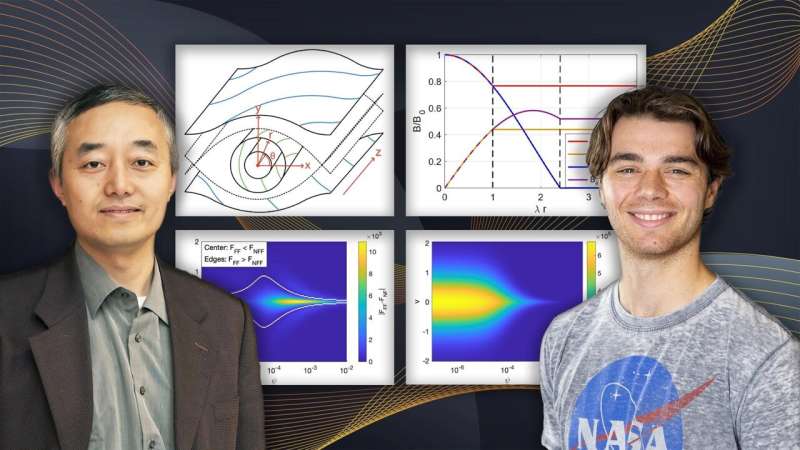New insight into blobs improves understanding of a universal process

Researchers at the U.S. Department of Energy's (DOE) Princeton Plasma Physics Laboratory (PPPL) have gained insight into a fundamental process found throughout the universe. They discovered that the magnetic fields threading through plasma, the charged state of matter composed of free electrons and atomic nuclei, can affect the coming together and violent snapping apart of the plasma's magnetic field lines. This insight could help scientists predict the occurrence of coronal mass ejections, enormous burps of plasma from the sun that could threaten satellites and electrical grids on Earth.
The scientists focused on the role of guide fields, magnetic fields threading through plasma blobs, or chunks, known as plasmoids. The guide fields add rigidity to the system and ultimately affect the ratio of large plasmoids to small ones and help determine how much reconnection occurs.
Plasmoid reconnection resembles the parallel computing that occurs in smart phones or in high-powered computers that model the weather. During this computing, many processors are calculating simultaneously and making the overall calculation rate quicker. Similarly, plasmoids speed up the overall rate of reconnection by making it occur in many places at once.
"Understanding how guide magnetic fields affect plasmoids could give us a better idea of what affects magnetic reconnection on the sun and stars, and throughout the cosmos," said Stephen Majeski, lead author of a paper reporting the results in Physics of Plasmas and a graduate student in Princeton University's Program in Plasma Physics. "Guide fields are a knob we can turn up to reveal new information."
The results provide insight into the ejection of large masses of plasma that speed across space and strike the Earth's magnetosphere, the sheath of magnetic field lines surrounding our planet that protects us from high-energy particles. These giant plasma burps, if large enough, could damage the satellites that enable smart phones to provide driving directions and other applications. The burps could also damage electrical power grids on Earth. "This is all something you definitely want to be aware of," Majeski said.
"This is new territory for plasmoid reconnection research," said Hantao Ji, professor of astrophysical science at Princeton University and distinguished research fellow at PPPL, who helps manage PPPL's Magnetic Reconnection Experiment (MRX) that studies reconnection. "Majeski has added to our knowledge about guide fields to make progress toward understanding large-scale reconnection based on plasmoids. Nobody has looked at guide fields in this way before."
Plasmoid reconnection with guide fields also occurs in doughnut-shaped tokamaks, the most widely used type of fusion facility around the world that use powerful magnets to confine plasma in the effort to harness on Earth fusion, the power that drives the sun and stars. Fusion combines light elements in the form of plasma to generate massive amounts of energy, a process that scientists are seeking to replicate for a virtually inexhaustible supply of power to generate electricity.
The researchers plan to make the models more accurate by including more physical effects, like the speed at which plasmoids combine. They also intend to perform experiments using MRX and PPPL's new Facility for Laboratory Reconnection Experiment (FLARE), the large successor to MRX. FLARE will help probe how quickly reconnection takes place in large laboratory plasmas that are more relevant to astrophysical plasmas, and how the magnetic energy turns into explosive thermal energy.Research reveals how plasma swirling around black holes can produce heat and light
No comments:
Post a Comment